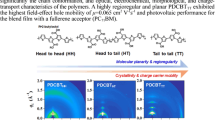Abstract
Four kinds of polythiophenes have been doped with CH3SO3H in CHCl3 under air, oxygen, and nitrogen. In the doping of two types of poly(3-hexylthiophene)s, P3HexTh(Zn/Ni) and P3HexTh(Fe) with different contents of a head-to-tail unit, the p-doping occurs at a similar rate. The reaction between poly(3-dodecylthiophene), P3DodTh, and the acid takes place more rapidly. P3OBuTh with a butoxy substituent undergoes more facile p-doping and receives photochemical reaction with CHCl3, and this reaction obeys a pseudo-first-order rate law with a rate constant k obs of 1.42×10−5 s−1 at room temperature.
Similar content being viewed by others
References
Heeger A J. Semiconducting and metallic polymers: The fourth generation of polymeric materials. Angew Chem Int Edit, 2001, 40: 2591–2611
MacDiarmid A G. Synthetic metals: A novel role for organic polymers. Rev Mod Phys, 2001, 73: 701–712
Shirakawa H. The discovery of polyacetylene film: The dawning of an era of conducting polymers. Angew Chem Int Edit, 2001, 40: 2575–2580
Friend R H, Gymer R, Holmes A, et al. Electroluminescence in conjugated polymers. Nature (London), 1999, 397: 121–128
Sirringhaus H, Tessler N, Friend R H. Integrated optoelectronic devices based on conjugated polymers. Science, 1998, 280: 1741–1744
Yamamoto T. π-Conjugated polymers with electronic and optical functionalities: Preparation by organometallic polycondensation, properties, and applications. Macromol Rapid Comm, 2002, 23: 583–606
Chen T-A, Wu X, Rieke R D. Regiocontrolled synthesis of poly(3-alkylthiophenes) mediated by rieke zinc: Their characterization and solid-state properties. J Am Chem Soc, 1995, 117: 233–244
Le’re-Porte J-P, Moreau J J E, Torreilles C. Highly conjugated poly(thiophene)s: Synthesis of regioregular 3-alkylthiophene polymers and 3-alkylthiophene/thiophene copolymers. Eur J Org Chem, 2001, 2001: 1249–1258
Hotta S, Rughooprth S D, Heeger A J. Conducting polymer composites of soluble polythiophenes in polystyrene. Synth Met, 1987, 22: 79–87
Yamamoto T, Sakamaki M, Fukumoto H. π-Doping behavior of water-soluble π-conjugated poly[3-(3-sulfopropyl)thiophene]: Kinetic and spectroscopic studies. Synth Met, 2003, 139: 169–173
Yamamoto T, Shimizu T, Kurokawa E. Doping behavior of water-soluble π-conjugated polythiophenes depending on pH and interaction of the polymer with DNA. React Funct Polym, 2000, 43: 79–84
Imit M, Yamamoto T, Imin P. Photochemical reactions of poly(3-butoxythiophene-2,5-diyl) with chloroform. J Zhejiang Univ Sci, 2005, 6B: 722–724
Yamamoto T, Omote M, Miyazaki Y, et al. Poly(thiophene-2,5-diyl)s with a crown ethereal subunit preparation, optical properties, and n-doping state stabilized against air. Macromolecules, 1997, 30: 7158–7165
Miyazaki Y, Kanbara T, Osakada K, et al. Preparation of poly(alkoxythiophene-2,5-diyl)s by organometallic process and doping-undoping behaviors of the polymers. Chem Lett, 1993, 22: 415–418
Yamamoto T, Morita A, Miyazaki Y, et al. Preparation of π-conjugated poly(thiophene-2,5-diyl), poly(p-phenylene), and related polymers using zerovalent nickel complexes, linear structure and properties of the π-conjugated polymers. Macromolecules, 1992, 25: 1214–1221
Ikenoue Y, Chiang J, Patil A O, et al. Verification of the “cation-popping” doping mechanism of self doped polymers. J Am Chem Soc, 1988, 110: 2983–2987
Chen S A, Hua M Y. Structure and doping level of the self-acid-doped conjugated conducting polymers: Poly[n-(3′-thienyl)alkanesulfonic acids]. Macromolecules, 1993, 26: 7108–7113
Hua M Y, Yang S W, Chen S A. Sensitive thermal-undoping characteristics of the self-acid-doped conjugated conducting polymer poly[2-(3′-thienyl)-ethanesulfonic acid]. Chem Mater, 1997, 9: 2750–2753
Pei Q, Zuccarello G, Ahlskog M, et al. Electrochromic and highly stable poly(3,4-ethylenedioxythiophene) switches between opaque blue-black and transparent sky blue. Polymer, 1994, 35: 1347–1351
Hanna R, Leclerc M. Synthesis and characterization of new processible conducting copolymers derived from thiophenes. Chem Mater, 1996, 8: 1512–1518
Yu Y, Gunic E, Zinger B, et al. Spectra and reactivity of methoxyoligothiophene cation radicals. J Am Chem Soc, 1996, 118: 1013–1018
Kumar A, Welsh D M, Morvant M C, et al. Conducting poly(3,4-alkylenedioxythiophene) derivatives as fast electrochromics with high-contrast ratios. Chem Mater, 1998, 10: 896–902
Daoust G, Leclerc M. Structure-property relationships in alkoxy-substituted polythiophenes. Macromolecules, 1991, 24: 455–459
Castagnola M, Floris B, Illuminati G, et al. The electron donor properties of ferrocene, the oxidation of ferrocene by carboxylic acids. J Organometal Chem, 1973, 60: 17–18
Floris B, Illuminati G, Ortaggi G. The ring basicity of ferrocene and related compounds. Tetrahedron Lett, 1972, 4: 269–272
Author information
Authors and Affiliations
Corresponding authors
Rights and permissions
About this article
Cite this article
Mokhtar, I., Takakazu, Y. & Patigul, I. A comparative study on p-doping behavior of polythiophenes with CH3SO3H. SCI CHINA SER B 50, 18–22 (2007). https://doi.org/10.1007/s11426-007-0002-3
Received:
Accepted:
Issue Date:
DOI: https://doi.org/10.1007/s11426-007-0002-3




